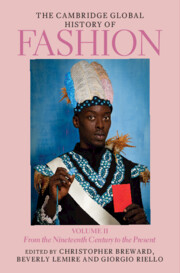Book contents
- The Cambridge Global History of Fashion
- The Cambridge Global History of Fashion
- The Cambridge Global History of Fashion
- Copyright page
- Contents for Volume II
- Figures for Volume II
- Maps for Volume II
- Table for Volume II
- Contributors for Volume II
- Preface
- Part IV Fashion, Modernism, and Modernity
- Part V Fashion, Colonialism, and Post-Colonialism
- Part VI Fashion Systems and Globalization
- 35 Manufacturing Fashion in the Post-War Period
- 36 Producing and Predicting Fashion in Twentieth-Century America and Europe
- 37 The Origins and Development of Haute Couture, 1858 to Now
- 38 Couture, Prêt-à-Porter, and Fast Fashion since 1945
- 39 Casualwear and Its Birth in Japan
- 40 Fashion and Globalization
- 41 Streetscape, Shop Window, Museum Vitrine
- 42 Fashion and Global Sustainability
- Index
- References
41 - Streetscape, Shop Window, Museum Vitrine
Displaying Fashion, c. 1800–2000
from Part VI - Fashion Systems and Globalization
Published online by Cambridge University Press: 04 August 2023
- The Cambridge Global History of Fashion
- The Cambridge Global History of Fashion
- The Cambridge Global History of Fashion
- Copyright page
- Contents for Volume II
- Figures for Volume II
- Maps for Volume II
- Table for Volume II
- Contributors for Volume II
- Preface
- Part IV Fashion, Modernism, and Modernity
- Part V Fashion, Colonialism, and Post-Colonialism
- Part VI Fashion Systems and Globalization
- 35 Manufacturing Fashion in the Post-War Period
- 36 Producing and Predicting Fashion in Twentieth-Century America and Europe
- 37 The Origins and Development of Haute Couture, 1858 to Now
- 38 Couture, Prêt-à-Porter, and Fast Fashion since 1945
- 39 Casualwear and Its Birth in Japan
- 40 Fashion and Globalization
- 41 Streetscape, Shop Window, Museum Vitrine
- 42 Fashion and Global Sustainability
- Index
- References
Summary
It may be argued that simply by wearing clothing and adorning our bodies every day, each of us participates in a kind of display. Dress is a means by which humans present themselves in society, and for centuries, those at the top of society used dress in ways that displayed their power, status, and leisure. As social structures evolved and changed in the nineteenth century, the display of dress took on a different character. After the French Revolution and with the long-term rise of the middle class, more and more people could participate in the pleasure of conspicuous consumption. The venues for this display were no longer the fixtures of political power – palace and church – but instead, the much more democratic street and store. In addition, fashion became understood as a phenomenon that defined modernity itself.
- Type
- Chapter
- Information
- The Cambridge Global History of FashionFrom the Nineteenth Century to the Present, pp. 1422 - 1454Publisher: Cambridge University PressPrint publication year: 2023



